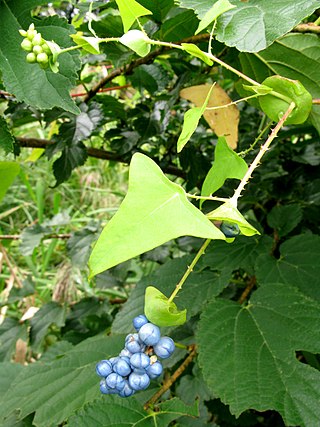
Persicaria perfoliata is a species of flowering plant in the buckwheat family. Common names include mile-a-minute, devil's tail, giant climbing tearthumb, and Asiatic tearthumb. It is a trailing herbaceous annual vine with barbed stems and triangular leaves. It is native to most of temperate and tropical eastern Asia, occurring from eastern Russia and Japan in the north, and the range extending to the Philippines and India in the south. P. perfoliata is an aggressive, highly invasive weed.

Gypsophila is a genus of flowering plants in the carnation family, Caryophyllaceae. They are native to Eurasia, Africa, Australia, and the Pacific Islands. Turkey has a particularly high diversity of Gypsophila taxa, with about 35 endemic species. Some Gypsophila are introduced species in other regions.

Claytonia perfoliata, also known as miner's lettuce, Indian lettuce, winter purslane, or palsingat (Cahuilla), is a flowering plant in the family Montiaceae. It is an edible, fleshy, herbaceous, annual plant native to the western mountain and coastal regions of North America.

Gypsophila paniculata, the baby's breath, common gypsophila or panicled baby's-breath, is a species of flowering plant in the family Caryophyllaceae, native to central and eastern Europe. It is an herbaceous perennial growing to 1.2 m (4 ft) tall and wide, with mounds of branching stems covered in clouds of tiny white flowers in summer. Another possible source of this name is it scent, which has been described as sour milk, like a baby’s “spit-up”. Its natural habitat is on the Steppes in dry, sandy and stony places, often on calcareous soils. Specimens of this plant were first sent to Linnaeus from St. Petersburg by the Swiss-Russian botanist Johann Amman.

Gypsophila elegans, the annual baby's-breath or showy baby's-breath, is an ornamental plant native to Asia and Europe.
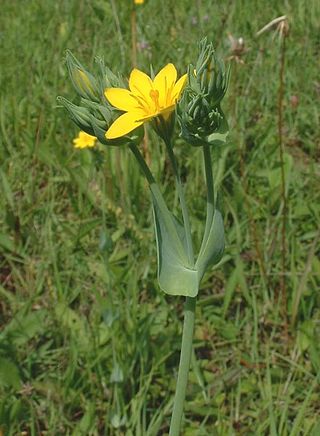
Blackstonia perfoliata or yellow-wort is a species of flowering plant in the family Gentianaceae found around the Mediterranean Basin, but extending into northwestern Europe.

The variable limestone babbler is a species of bird in the family Pellorneidae. It is found in the limestone hills of northern and eastern Thailand northwest to southern Myanmar. Two other Gypsophila species, the Annam limestone babbler and the rufous limestone babbler were previously considered subspecies of crispiforns, but a 2020 study found them to be distinct species.

Triodanis perfoliata, the clasping Venus' looking-glass or clasping bellflower, is an annual flowering plant belonging to the family Campanulaceae. It is an annual herb native to North and South America, the natural range extending from Canada to Argentina. It is also naturalized in China, Korea and Australia.
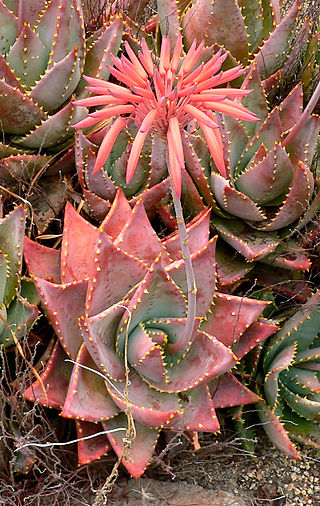
Aloe perfoliata, the rubble aloe or mitre aloe, is a hardy creeping aloe, found in rocky, mountainous areas throughout the Western Cape, South Africa.

Veronica perfoliata, commonly known as digger's speedwell, is a common perennial herb found at higher altitudes in south-eastern Australia. It is a low-growing multi-stemmed plant rising from a woody rootstock. It has rounded blue-grey foliage and sprays of intense violet-blue flowers at the end of arching branches. It is occasionally cultivated as a garden plant.

Aloe ser. Mitriformes is a taxonomic series within the genus Aloe, comprising several closely related species of Southern African rambling aloe. These typically multi-branched sprawling aloe species have rigid fleshy leaves and slender pedicels about the length of the perianth, each being roughly 40 mm long. The stems tend to sprawl along the ground, with the ends densely leafed and upturned.

The jungle babblers are a family, Pellorneidae, of mostly Old World passerine birds belonging to the superfamily Sylvioidea. They are quite diverse in size and coloration, and usually characterised by soft, fluffy plumage and a tail on average the length of their body, or longer. These birds are found in tropical zones, with the greatest biodiversity in Southeast Asia and the Indian subcontinent.
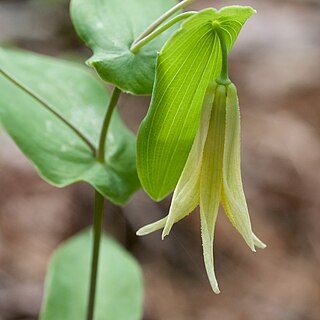
Uvularia perfoliata, the perfoliate bellwort, is a perennial forb native to the eastern United States and Canada, which produces pale yellow flowers in spring.

Psammophiliella is a genus of flowering plants in the family Caryophyllaceae. It has only one species, Psammophiliella muralis, known as annual gypsophila, cushion baby's-breath and low baby's-breath, an annual plant principally native to Europe except the British Isles. It can be also found in Central Asia, Turkey, the Caucasus, and Siberia.
Eucalyptus gypsophila, also known as the kopi mallee, is a species of mallee that is native to Western Australia and South Australia. It has rough, flaky bark on the lower part of the trunk, smooth light grey bark above, lance-shaped adult leaves, flower buds mostly in groups of between seven and eleven, creamy white flowers and conical to cylindrical fruit.

Crassula perfoliata is the type species of the genus Crassula, in the flowering plant family Crassulaceae, where it is placed in the subfamily Crassuloideae. It was first formally described by Linnaeus in 1753 as one of 10 species of Crassula. It is from South Africa.

Sanrobertia is a genus of flowering plants within the subtribe Symphyotrichinae of the family Asteraceae. It is monotypic, meaning there is only one species within the genus. Sanrobertia gypsophila is a rare endemic known only from Nuevo León, Mexico.
Limestone wren-babbler has been split into three species:
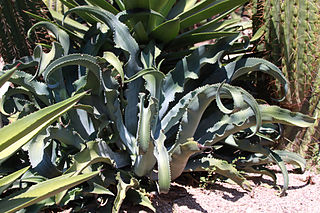
Agave gypsophila is a species of plant in the Asparagaceae family and is endemic to the Mexican state of Guerrero. The specific epithet, gypsophila, means gypsum loving.
Passiflora perfoliata is a species of plant in the family Passifloraceae.

















